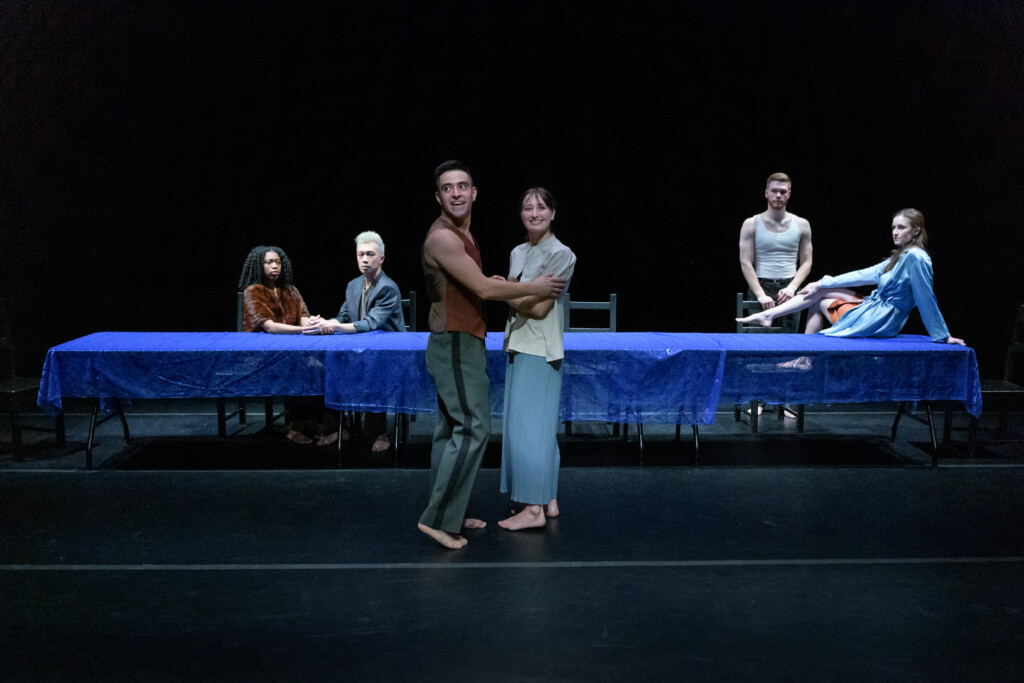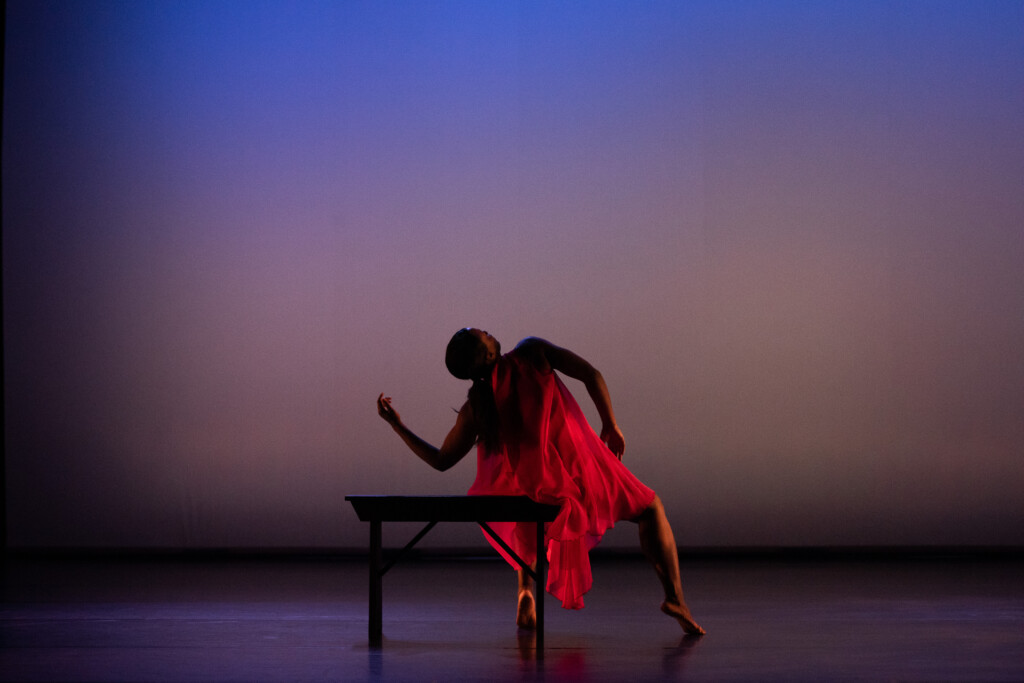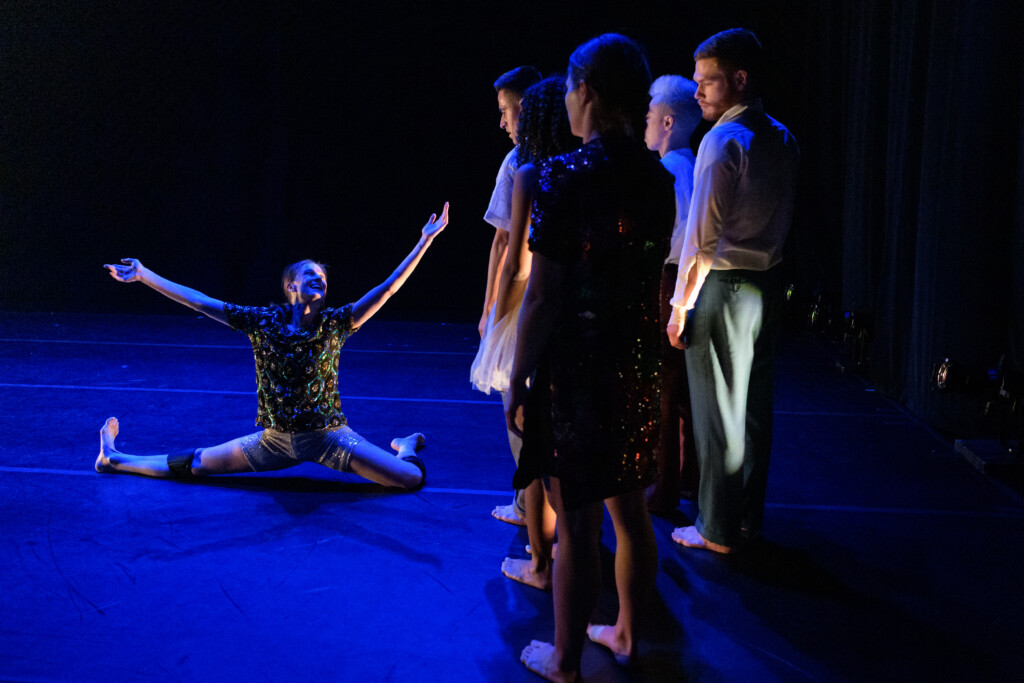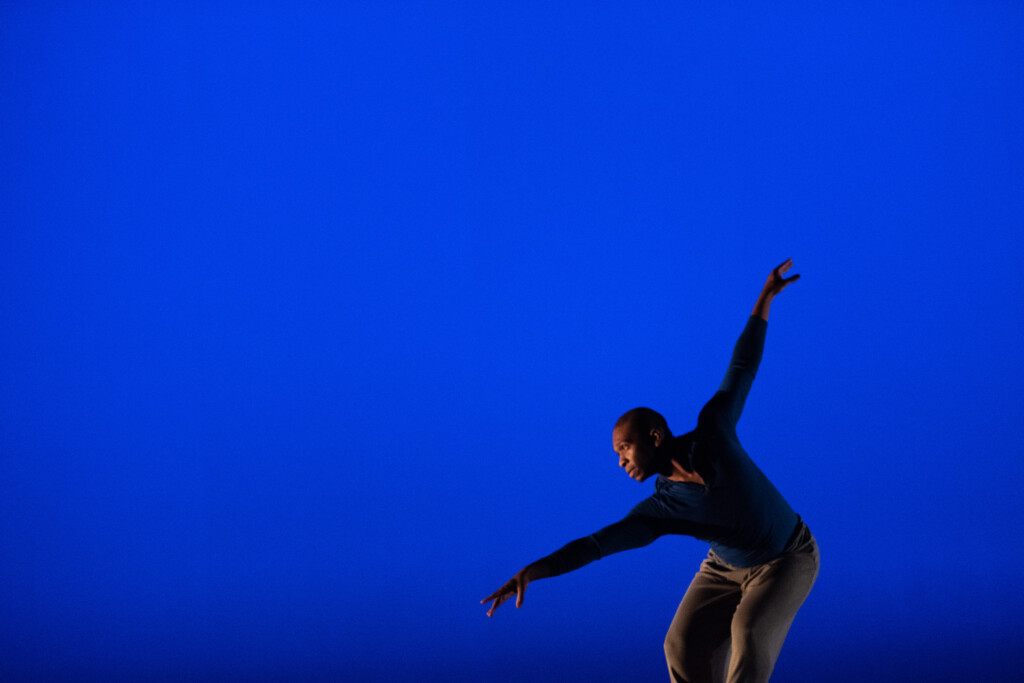The Utah Review offers reviews of two dance concerts: the live performance of Ririe-Woodbury Dance Company’s Fill in the Blank and Repertory Dance Theatre’s Emerge concert film.
RIRIE-WOODBURY DANCE COMPANY: FILL IN THE BLANK
In a word. Ririe-Woodbury Dance Company’s Fill in the Blank concert was superb. Tremendous emotional intensity propelled the enthralling pace of the entire program, comprising a world premiere by a Utah choreographer and former dance artist of the company, a Utah premiere of a work inspired by a classic film from the 1960s and the company’s first performance of a repertoire work in its entirety.
In the Regent Street Black Box Theatre of the Eccles Theater, the company’s six dance artists exhibited a strong cohesive chemistry in their ensemble work— a notable achievement considering that five of them have joined within the last two seasons.
The world premiere of coincidences, when we meet up by jo Blake with an original score by locally based composer Trevor Price effectively established the theme behind the concert’s title. How does one overcome feeling awkwardly self-conscious and steadily gain confidence in the way they move and communicate with others who are familiar or new in their circle of relationships? Blake sets movement that elegantly replicates the gradual organic character of finding the ideal comfort zone in relationships and interactions, especially when times and events are as complicated as they have been within the last couple of years. The trio for the final performance during the run comprised Peter Farrow, Megan McCarthy and Fausto Rivera. They made a convincing portrayal of achieving that fluid seamless goal we desire in our interactions as the space encompassing the movement tightened for more intimate impact. The black box space enhanced the exquisite chamber ensemble vibe of Blake’s tender, sensitive artistic vision.
Filling in the blank for the performance of Andrea Miller’s I can see myself, a 2010 work (formerly known as Pupil Suite and the reconstruction by Haley Sung and Dan Walczak), this reviewer recommends a barnburner of epic fabulous proportions. The company’s six artists (Peter Farrow, Megan McCarthy, Fausto, Rivera, Corinne Lohner, Alexander Pham, Miche’ Smith) picked up and amplified the energetic response coming from the audience. During the pandemic, the company has produced several excellent concert films but nothing replaces the heartfelt exuberance of the performance of Miller’s rollicking, sassy, sexy, smart creation. The work is grueling and complex, set to the driving back beats of the Israeli band Balkan Beat Box. It leaves a narrow margin for error in rhythmic and synchronizing precision. Also, the work succeeds when the dance artists embrace the theatrics of the moment, with gestures, facial expressions and glimpses of their genuine personalities.

The live performance of Miller’s work in its entirety was delayed because of the pandemic. But, the company presented a section of it in last season’s closing film concert Cadence. At the time, The Utah Review noted, “Don’t miss McCarthy’s solo, which brings the zany pace to an abrupt halt in the middle, as she struggles to recover her stance after her legs go limp and she contorts herself, only to fall back once again. Oh, to have McCarthy’s flexibility.” Seeing it live reaffirmed this assessment.
The theatrical impact was as evident in the Utah premiere of Look Who’s Coming to Dinner, a 2019 work by Stefanie Batten Bland and reconstructed by Latra Wilson, along with an original score by Paul Damian Hogan. Set around a dinner setting, the work is inspired by Guess Who’s Coming to Dinner?, the 1967 film directed by Stanley Kramer which revolved around an interracial relationship. The film was released in the same year that the U.S. Supreme Court ruled in Loving v. Virginia that laws banning interracial relationships violated the 14th Amendment to the U.S. Constitution.

Bland’s work is an excellent complement to Blake’s premiere presented earlier in the evening. The work begins with the dancers acting nervously and uncomfortably, once they remove their masks. Dinners, especially in a setting similar to the premise of the film, can unfold like tentative choreography, with each participant excruciatingly conscious of every gesture, word, or interaction involved in this social dance. Once the tables are flipped on their side to become doors, the work’s rhythm and momentum slow to a churning point of tension, not unlike the narrative arc in the film. Bland’s work also magnifies a theme that often has not been discussed about the 1967 film and that points to gender inequality, which became just as apparent in the narrative when the father, realizing that he never again will be able to tell his daughter what to do, tells her to shut up during the dialogue when he finally gives his blessing to the marriage.
The concert also was recorded and is available for on-demand viewing with purchased access. For more information, see the Ririe-Woodbury website.
REPERTORY DANCE THEATRE: EMERGE: SOUNDS DELIGHTFUL
Normally, the first weekend of the new year has featured a live edition of Emerge, which encompasses short works created by dance artists of Repertory Dance Theatre (RDT). But, the rapid surge in COVID-19 cases at the time scrapped the live performances and last week the company released a film of the works, which is now available with a purchased ticket until March 6.
As mentioned in a preview published last month at The Utah Review, the theme of this year’s Emerge was to feature works inspired by familiar music of the 1930s and 1940s. The results became a delightful panoply of styles and genres, with names such as Artie Shaw, Bing Crosby, Duke Ellington, Glenn Miller, Billie Holiday and composers including Carl Orff and Samuel Barber.
The concert, in its sixth edition, fulfills in part a major component of the dance artist’s contract for RDT. Since its founding 56 years ago, the company not only has dedicated its mission to preserving the historic canon of modern dance but also to create work to build a diversified repertoire. Many of the nearly 110 RDT alumni have become internationally known choreographers and some have founded their own dance companies producing works that have premiered on the RDT stage.
The concert also featured a world premiere of Hold by Kaley Pruitt, the winner of RDT’s 2021 Regalia choreographer’s competition. Pruitt set the work based on Samuel Barber’s Adagio for Strings, as recorded by the New York Philharmonic led by Leonard Bernstein. The 1936 work is one of the most recognized from among 20th century American composers.
In an earlier interview with The Utah Review, In thinking about the movement for the composition, Pruitt says she focused on the simultaneous presence of doubts, fears and hopes while finding an opportunity to appreciate a joyous moment of life at least for the moment without the regret of thinking too far ahead. Indeed, she says it is meant as a healing moment, an opportunity to rebalance ourselves — dancers and audiences included.

The result was a remarkably faithful interpretation of the musical structure in the Barber piece. There is a tentative, almost thoroughly uncertain, crotchet movement that ascends in the music and is passed around to the various players. The rhythmic foundations shift as the music builds an arch and Pruitt replicates this with impressive effect in the dancers. The dance artists open up the movement space, replicating clearly the crossovers suggested in the music. Pruitt succeeds at heightening the already profound emotional foundation of the music, most notably at the melodic peak of the music where the bass line has been stripped out and the movement takes on a near-ethereal floating sensation. The company responded fully to the poignant demands of this outstanding interpretation.
Some of the short works created by RDT dance artists capitalized handsomely on the straightforward structures of Big Band and swing music with its well-defined melodies, back beats and driving rhythmic structure.
The concert opener, choreographed by RDT artistic associate Nicholas Cendese, featured Utah Valley University dance students who had participated in RDT’s Winterdance Workshop. It was a delightful aperitif in salute of the Glenn Miller sound that was an icon for the period. In Hobbledehoy, Lindsey Faber and Megan O’Brien were charming as newcomers scurrying out of a pile of clothes in movement set to Star Dust by Artie Shaw and Small Fry by Bing Crosby and written by Johnny Mercer. The large prop piles subsequently were donated to a local clothing drive.
RDT dance artists did solid justice to the music they selected. Lauren Lenning set Billie Holiday’s Willow, Weep for Me for students she has mentored at the Creative Arts Academy. Daniel Do deftly crafted a lovely compilation of solos and ensembles for guest dance artists Kenzie Allred, Madaline Maravillas and Alicia Trump, featuring music by Holiday, Miller, Ella Fitzgerald and the Delta Rhythm Boys and the Harold Arlen classic (Somewhere) Over the Rainbow, as sung by Judy Garland.
Some of the other RDT artists took different paths, with absorbing and satisfying results. In The Afternoon, performed by Ursula Perry and choreographed in collaboration with Cendese, featured music by Sidney Bechet. Seated at times on a small bench one might find in a park, Perry brought to life the unique gravitational pull of Bechet’s music and how the sequences of the 12-bars blues structure carry the movement from one section to another. There is a stately, deliberate vibe in the music and Perry telegraphed that perfectly.
Jonathan Kim’s After Record End, which he performed with Ruby Cabbell, was a sophisticated, intelligent choreographic morphing meditation about memories juxtaposing two different musical representation of the time: Al Bowlly’s Remember Me, as recorded by the Ray Noble Orchestra, and the Andante movement of Ruth Crawford Seeger’s String Quartet. At first, memories are clear, even piercing but as time progresses, they become twisted, entangled and ever shifting amidst a mass that becomes denser, and more dissonant with time. This was bold, satisfying movement making.

Dan Higgins’ Two Palomas and a French Slim is a blended sacred and sultry tribute to Duke Ellington’s Come Sunday. Higgins incorporates the prop of a table into his movement but he effectively uses it to transmit how a memory seemingly constrained or boxed in can be liberated. How does one embrace the juxtapositions or what might be restricting contradictions in one’s life, especially as one cultivates and nourishes the philosophy that propels not only their daily existence but also their creative expression. Higgins could not have picked a more appropriate Ellington song, intoxicating as it is meditative in only the way that the great musician could express. Come Sunday, which has ironically become a standard in jazz religious services, is infused with the Black spiritual and Scottish song traditions. Ellington resisted all dogma. He never regretted the vices he enjoyed, including alcohol and smoking. But, he was unquestionably a spiritual man, as encompassed in Come Sunday. And, Higgins paid fine tribute to a song that many Ellington enthusiasts consider to be the best he wrote.
Kareem Lewis also eschewed a familiar route by selecting O Fortuna, the grand chorus that bookends Carl Orff’s massive Carmina Burana. In Nascent, Lewis creates and performs a solo that is as exciting and grandiose as the music itself. The rhythms are simple but the structures that appear in the chorus parts are what really catches the listener’s attention. Likewise, Lewis does this beautifully in his choreographed movement, which also carries the greatest impact for the viewer. That main rhythmic pattern always stays and Lewis capitalizes on it magnificently as the excitement in the music builds. The melody is repetitive but then the cross rhythm that sounds like a clock ticking away appears and Lewis zeros on this perfectly. In the music’s final rush, the tierce de Picardie chord gives that liberating sense of relief after the buildup of enormous proportions — an effect that Lewis renders memorably in his closing.
For more information about purchasing access to the Emerge concert film, see the RDT website.




2 thoughts on “Two excellent dance concerts: Ririe-Woodbury’s Fill in the Blank; Repertory Dance Theatre’s Emerge: Sounds Delightful”